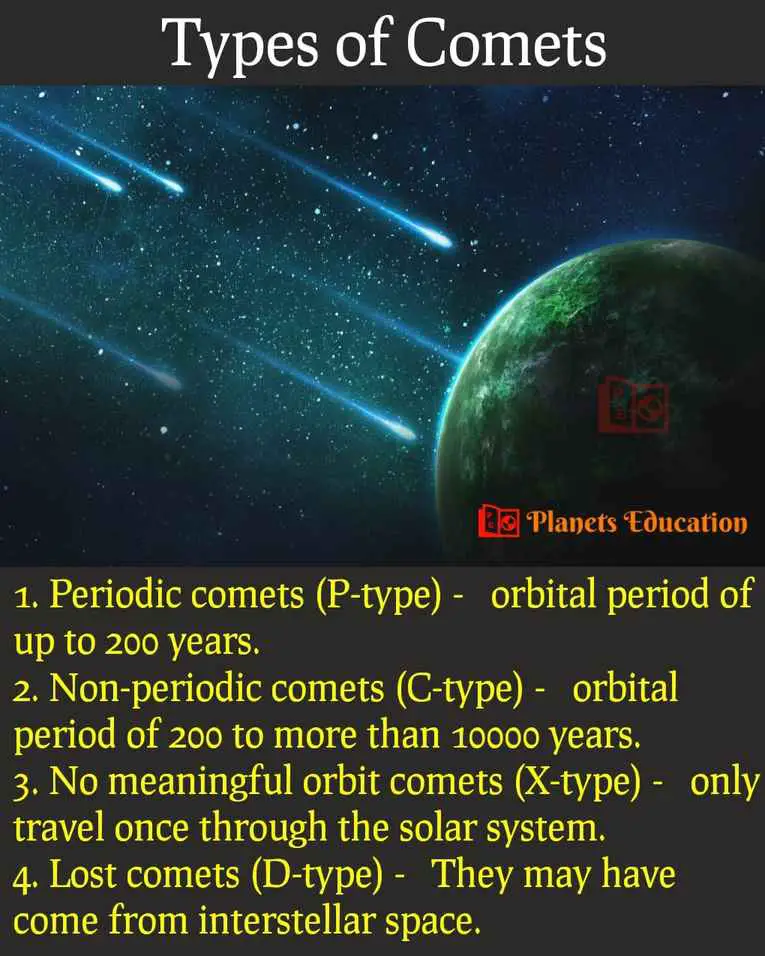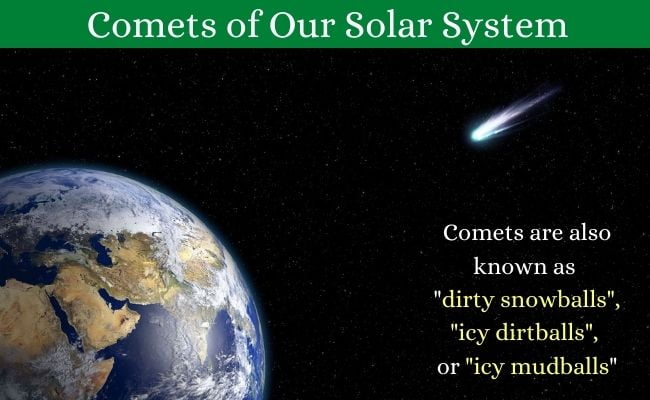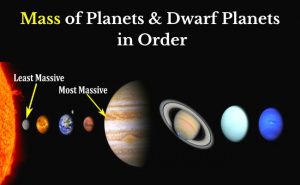Comets are small icy bodies located in the Oort Cloud region of our solar system. When comets pass nearby to Sun then it releases gases and appears as a giant glowing body.
The formation of the solar system had started around 4.5 billion years ago and scientists believe Comets are the leftovers from the formation of the solar system. They are cold and icy bodies composed of gases and dust particles.
Comets are also known as “dirty snowballs”, “icy dirtballs”, or “icy mudballs”.
Here in this article, we will read about what are comets, what are they made of, the physical structure and types of comets, where are they found, and many interesting information and facts about comets.
What are Comets?
Comets are small solar system bodies made up of gases, dust, and ice. There are billions of comets in our solar system. They exist beyond the orbit of Neptune and mostly located in the Oort cloud region of the solar system.
Usually, comets are small in size and hardly can be up to 50 kilometers in size, whereas most are below 20 kilometers in size. But when the comet reaches near to the sun, then it glows while releases gages and dust. The glowing part of the comets are called “coma” and it can be up to millions of kilometers in size, sometimes even larger than the sun.
The solar wind and radiation pressure of the Sun exert a force on the coma and create an enormous long “tail” that points away from the sun. And the tail can be several hundred million kilometers in size.
What are comets made of?
Comets are mostly made of rocks, dust, water ice, carbon dioxide (CO2), carbon monoxide (CO), methane, and ammonia. It also contains some organic compounds that can include methanol, formaldehyde, ethanol, hydrogen cyanide, ethane, amino acids. They are highly dusted content bodies, so they are called “icy dirtballs”.
Below are described the physical parts/structure of the comets:
Nucleus:
The core and solid structure of a comet are called its nucleus. And it is the real size of a comet when it is further from the sun. The nucleus is small in size and can vary few meters to 50 km in diameter. Usually, they are not visible and almost impossible to detect from the earth because of their small size.
Coma:
The very thin atmosphere of gas and dust released from the comets are called “coma”. The coma of comets is only visible when it comes near to the sun (generally 3-5 AU from the sun).
When the comets reach near to the sun, the ice and dust start vaporizing and make a thin atmosphere or coma around the nucleus. This part is quite large in size and sometimes larger than planets and even the sun.
Tails
When the comet reaches near to the sun it starts outgassing/vaporizing and creates a coma. Many of the times it reaches so near to the sun that the sun’s radiation and solar wind exert pressure on the coma and that makes an enormous tail.
The tail can stretch more than 1 astronomical unit (AU) ( 1 AU is equal to the distance between Sun and Earth that is almost 150 million kilometers).
As we know, comets release gas and dust. So both gas and dust produce distinct tails. There are two types of tail produces in a comet when it reaches near to the sun while orbiting.
Gas tail:
This is made of gases and called type I or ion tail. It is almost in a straight line and directly points away from the sun.
Dust tail:
This is made of dust and called a type II tail. It also points away from the sun but because dust particles are heavier so this has a curved tail.
Types of Comets
According to their orbit around the sun, there are four types of comets in the solar system.
- Periodic comets (P-type)
- Non-periodic comets (C-type)
- No meaningful orbit comets (X-type)
- Lost comets (D-type)
Periodic (P-type)
These types of comets have a periodic orbit around the sun and repeat their orbital path. They are also known as Short-period or Halley-type comets.
Short-period comets are found mostly in the Kuiper belt region or scattered disk region. They have an orbital period of up to 200 years.
Non-periodic comets (C-type)
These types of comets are only seen once and have thousands of years of period time. They are categorized into two types:
- Long-period comets
- Near-parabolic type comets
Long-period comets are found in the near Oort cloud region. They may have an orbital period of 200 to 1000 years.
Near-parabolic type comets have a very long period of orbital time. Their orbital period is more than 1000 years. These comets are come from the Oort cloud region, with an orbit of around 10000 to 50000 AU from the sun.

No meaningful orbit comets (X-type)
These are the parabolic and hyperbolic period type comets of our solar system. They come from the outer Oort cloud region. They are not potentially bound to our sun and may only travel once through the solar system.
Lost comets (D-type)
These types of comets get lost after their discovery. They may have come from interstellar space. Usually, they do not orbit our sun.
Famous comets in our solar system
There are many famous comets in our solar system but here we have added the list of top 10 famous comets. Most of these comets are periodic and have been seen from the earth in past and could also be seen in the future.
| Name of Comet | Reason for Famous |
| 1. Halley | Halley comet is a periodic comet and visible from the earth every 76 years. |
| 2. Encke | It is one of the nearest period comets, completes one orbit every 3.3 years around the sun. |
| 3. Shoemaker Levy-9 | This is famous because it broke apart and collided with Jupiter in 1994. |
| 4. Hale Bopp | This was one of the brightest comets seen from the earth in the 20th century for many decades. |
| 5. Tempel 1 | It is a Jupiter-family type comet and orbits the sun every 5.5 years. |
| 6. Hyakutake | It was seen in 1996 from the earth and this was the closest approach of any comet in the previous 200 years. |
| 7. Hartley 2 | It is a small periodic comet with an orbital period of just 6.45 years. |
| 8. Oumuamua | This was the first known interstellar object detected passing through the Solar System. According to NASA Scientists, it could be a rogue comet or exocomet. |
| 9. Borrelly | It is a periodic comet visited by the spacecraft Deep Space 1 in 2001. The closest approach to the sun of this comet was on 1 February 2022. |
| 10. Wild 2 | According to scientists, this comet used to have an orbital period of 43 years but its orbit disturbed due to Jupiter’s gravitation and now it completes one orbit in just around 6.2 years. |
Frequently asked questions (FAQ)
Where are comets found?
Most comets in our solar system are found in the Oort cloud region. This region exists beyond Neptune orbit, almost 100 AU from the sun. Though they have other location, such as:
- Halley-type comets and Jupiter family comets – they exist before Neptune’s orbit.
- Short-period comets – After Neptune’s orbit and in the Kuiper belt region.
- Long-period comets – They located beyond the Scattered disk region, in the Oort cloud region.
You may also like checking about:-
- Asteroids: Types, and Near-Earth Asteroids with Facts
- Total Number of Moons in the Solar System with Facts
- 5 Best Solar System Backpacks in 2024
- Mass of Planets in Order from Lightest to Heaviest
- Star Projector {2024}: Star Night Light Projector




